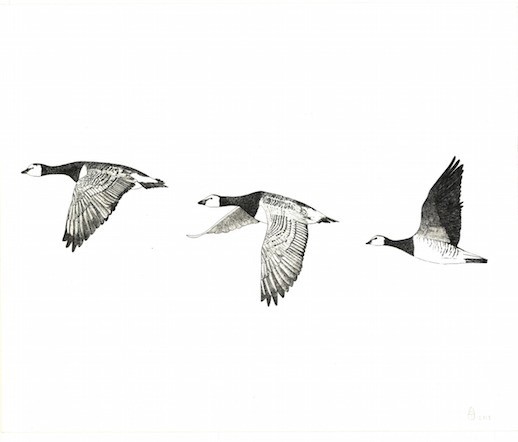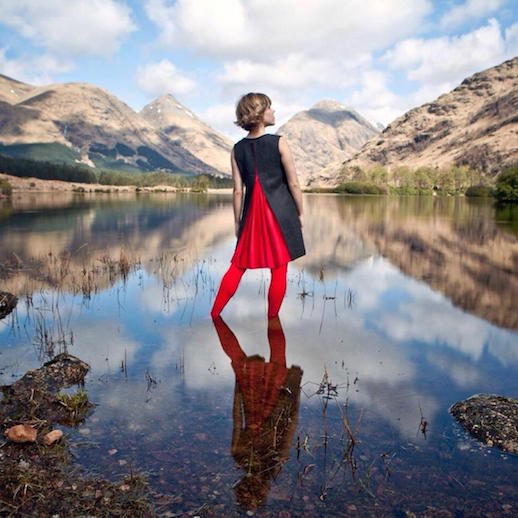An interview with Hanna Tuulikki by Rob St John
In 2014, a group of ten women performed a new vocal composition inspired by birds, Gaelic music and the landscape of the Isle of Canna, a small island off the west coast of Scotland. The performers – each dressed in costumes inspired in part by the plumage of waders such as the redshank and oystercatcher – sang together in the water of the island’s harbour, on the shoreline and on a floating, skein-shaped jetty. The piece “Air falbh leis na h-eòin – Away with the Birds”, explored the tradition of the mimesis of birds in Scottish Gaelic song, and was written and performed by artist and composer Hanna Tuulikki as part of a project commissioned by the Glasgow 2014 Cultural Programme.
Working with digital arts organisation The Space, Hanna has recently finished shaping the vast array of material, both consulted and created in Away with the Birds into an interactive, online environment. Where the original site-specific performance on Canna required audiences to travel to a small island off the Scottish coast, the new digital Away With the Birds landscape allows visitors to navigate through drawings, audio essays, studio recordings, film footage, field recordings and archive folk songs that form the constellation of this remarkable project, which here spreads its wings to take in material from across all of the Western Isles.
At the heart of Away with the Birds is a 3-metre wide pen and ink visual score created by Hanna. The score folds together the patterns and behaviours of Hebridean birds, both in flight and in song, with the new composition for ten voices. The score is split across five movements in horizontal bands (or ecotones, perhaps) which represent different elements of the shoreline environment: the shoreline; the cliffs with bird colonies; wading birds at ebb tide; flocks of different gull species, skeins of whooper swans and geese; and finally Manx shearwater flying back to their nests on land. Visitors can access the audio-visual material through a series of ‘hotspots’ in the score. Five ‘movement hotspots’ unpick the narrative meanings within each section and reveal the birds that feature within it; ten ‘song hotspots’ relate to each Gaelic song, and contains material about how the song and its relationship to birds, culture, and landscape, was interpreted in the project.
I spoke to Hanna on a balcony outside her studio at Edinburgh Sculpture Workshop, looking out over the city rooftops glowing in clear early September light. She explains, “The research for Away with the Birds stems from nine Gaelic songs and a handful of poems, which imitate, or emulate the sounds, movements and behaviours of birds. For me, the project grew from a desire to make connections (or re-form those connections) between the human and more-than-human world. Over the years, the project grew and developed an archive of material – songs, drawings, a visual score and performances – which even now, still has the power to surprise me!”
Away with the Birds is a major interdisciplinary work, drawing material from numerous sources, as Hanna describes, “The project was multilayered, stretching across a number of years, in an attempt to find ways of interdisciplinary working, and collaboration with a field-recordist-ornithologist, a filmmaker, a producer, a set builder, a costume designer, a performance director, a choreographer, and so on. And then there’s the birds, the songs and the landscape, and, of course, the vocal ensemble. As an ensemble, we didn’t just learn the score, but also learned about each other. We shared our skills and experiences from different backgrounds in traditional Gaelic, jazz and experimental music. The project knitted these various processes together, finding meeting points between ourselves and the more-than-human.”
The online score creates a space for visitors to interact with these different elements of the project in an intuitive way, led by their own curiosity. Hanna continues, “In the online work, I was interested in creating an experience without hierarchy, that gave an equality to all the different research elements, and moves fluidly between human and more-than-human, exploring specifically the sonic and cultural relationship between Gaelic song and bird. Most of these songs originate from women’s traditions, and so ‘Away With The Birds’ also has a double meaning.”
Gender relationships in the songs, their singing and their wider cultural resonances, was a key focus in Hanna’s research, composition and performance in Away with the Birds, “Most of these songs seem to me to come out of a matrilineal tradition, passed along a maternal line. Thematically, they are often sung from a women’s perspective, or within the women’s social domain. For example one of the songs is a keening song – ‘ pililuu’. Keening is a funerary practice that doesn’t really exist now, but was once the responsibility of women in highland communities. The song itself is imitative of the redshank, a wading bird that inhabits the liminal space between land and sea. To human ears, they appear to sing in a mournful manner, and you can begin to imagine why someone might imitate their sounds, in order to send the soul of the departed over to the next world.”
The traditional Gaelic songs and poems that underpin Away with the Birds, use some form of mimesis of birds, whether as the prelude to a hunt, or a threnody for a dead loved one. Hanna’s creative use of archival texts and recordings in Away with the Birds has the potential to help us examine the relationships between human culture and the landscape through time. “An important question to ask is ‘why is a song mimetic?’” Hanna explains, “I believe mimesis is the root of all our music making; we learn by imitating. When we examine traditional cultures in places where people have a more intimate relationship with the land, the music making is often much more integrated into people’s relationship with their environment, with musical sounds mimicking and blending with sounds of the land. Whilst Away with the Birds might seem like an experimental score, the sounds we’re working with feel very ancient, and in a way connect the contemporary to the pre-modern.”
Away with the Birds has a number of quiet but persuasive political resonances – evoking issues of land ownership and reform, the marginalisation (or museumification) of traditional cultures and practices in Scotland, and the interactions between people and environment. For Hanna, “I think that any work that is place-responsive is political by its very nature; it’s impossible for it not to be.” But perhaps one of the strengths of this work – both in its original and digital forms – is its openness and attentiveness to the world, without any ‘correct’ interpretation or interaction.
Instead, visitors to the digital Away with the Birds landscape encounter a highly original and enjoyable set of landscape traditions, sounds, stories and meanings that can be folded together in an intuitive and individual way. For Hanna, this was the intention all along, “Sometimes the score was composed from choosing sounds that could be moulded together to create a new landscape – or soundscape – and sometimes it was more conceptual, for example, based on the flocking or the skein. It was a blend between the intuitive and the conceptual. The score reveals meaning as you navigate through it: a process of discovery and surprise. Hopefully, the score allows the audience to move intuitively and make connections, in a similar fashion to the way I did during my research and explorations of landscape. It’s a space to open out the multiplicity of meaning embodied in these songs, and the traditions that have carried them.”
Away with the Birds digital landscape on The Space

